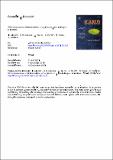Files in this item
UV luminescence characterisation of organics in Mars-analogue substrates
Item metadata
| dc.contributor.author | Laurent, B. | |
| dc.contributor.author | Cousins, C.R. | |
| dc.contributor.author | Gunn, M. | |
| dc.contributor.author | Huntly, C. | |
| dc.contributor.author | Cross, R. | |
| dc.contributor.author | Allender, E. | |
| dc.date.accessioned | 2019-12-18T00:37:54Z | |
| dc.date.available | 2019-12-18T00:37:54Z | |
| dc.date.issued | 2019-03-15 | |
| dc.identifier | 257005160 | |
| dc.identifier | b6e08b5a-78bd-4cc3-b2de-af78ddc407f3 | |
| dc.identifier | 85059153626 | |
| dc.identifier | 000460367200069 | |
| dc.identifier.citation | Laurent , B , Cousins , C R , Gunn , M , Huntly , C , Cross , R & Allender , E 2019 , ' UV luminescence characterisation of organics in Mars-analogue substrates ' , Icarus , vol. 321 , pp. 929-937 . https://doi.org/10.1016/j.icarus.2018.12.031 | en |
| dc.identifier.issn | 0019-1035 | |
| dc.identifier.other | RIS: urn:9CCA79E69396E46DF3132999B44E8896 | |
| dc.identifier.other | ORCID: /0000-0002-3954-8079/work/60196581 | |
| dc.identifier.other | ORCID: /0000-0002-0052-7895/work/64698159 | |
| dc.identifier.uri | https://hdl.handle.net/10023/19154 | |
| dc.description | This project was supported by a Leverhulme Trust Research Project Grant (RPG-2015-071). C Cousins also wishes to acknowledge funding by the Royal Society of Edinburgh. | en |
| dc.description.abstract | Detection of organic matter is one of the core objectives of future Mars exploration. The ability to probe rocks, soils, and other geological substrates for organic targets is a high priority for in situ investigation, sample caching, and sample return. UV luminescence – the emission of visible light following UV irradiation – is a tool that is beginning to be harnessed for planetary exploration. We conducted UV photoluminescence analyses of (i) Mars analogue sediments doped with polyaromatic hydrocarbons (PAHs; <15 ppm), (ii) carbonaceous CM chondrites and terrestrial kerogen (Type IV), and (iii) synthetic salt crystals doped with PAHs (2 ppm). We show that that detection of PAHs is possible within synthetic and natural gypsum, and synthetic halite. These substrates show the most apparent spectral modifications, suggesting that the most transparent minerals are more conducive to UV photoluminescence detection of trapped organic matter. Iron oxide, ubiquitously present on Mars surface, hampers but does not completely quench the UV luminescence emission. Finally, the maturity of organic carbonaceous material influences the luminescence response, resulting in a reduced signal for UV excitation wavelengths down to 225 nm. This study demonstrates the utility of UV luminescence spectroscopy for the analysis of mixed organic-inorganic materials applicable to Mars exploration. | |
| dc.format.extent | 2424056 | |
| dc.language.iso | eng | |
| dc.relation.ispartof | Icarus | en |
| dc.subject | UV luminescence | en |
| dc.subject | Mars | en |
| dc.subject | Analogue | en |
| dc.subject | Spectroscopy | en |
| dc.subject | Organic | en |
| dc.subject | GE Environmental Sciences | en |
| dc.subject | QC Physics | en |
| dc.subject | NDAS | en |
| dc.subject.lcc | GE | en |
| dc.subject.lcc | QC | en |
| dc.title | UV luminescence characterisation of organics in Mars-analogue substrates | en |
| dc.type | Journal article | en |
| dc.contributor.sponsor | The Leverhulme Trust | en |
| dc.contributor.sponsor | The Royal Society of Edinburgh | en |
| dc.contributor.institution | University of St Andrews. School of Earth & Environmental Sciences | en |
| dc.contributor.institution | University of St Andrews. St Andrews Centre for Exoplanet Science | en |
| dc.identifier.doi | 10.1016/j.icarus.2018.12.031 | |
| dc.description.status | Peer reviewed | en |
| dc.date.embargoedUntil | 2019-12-18 | |
| dc.identifier.grantnumber | RPG-2015-071 | en |
| dc.identifier.grantnumber | en |
This item appears in the following Collection(s)
Items in the St Andrews Research Repository are protected by copyright, with all rights reserved, unless otherwise indicated.

